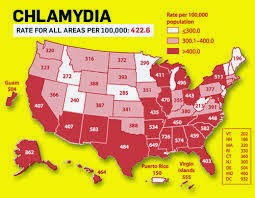Chlamydia
Chlamydia is a common sexually transmitted disease (STD) that can be easily cured. If left untreated, chlamydia can make it difficult for a woman to get pregnant.
Chlamydia is a common STD that can infect both men and women. It can cause serious, permanent damage to a woman's reproductive system, making it difficult or impossible for her to get pregnant later on. Chlamydia can also cause a potentially fatal ectopic pregnancy (pregnancy that occurs outside the womb).
is a common sexually transmitted infection in humans caused by the bacterium Chlamydia trachomatis. The term Chlamydia infection can also refer to infection caused by any species belonging to the bacterial family Chlamydiaceae. C. trachomatis is found only in humans.Chlamydia is a major infectious cause of human genital and eye disease. Chlamydia infection is one of the most common sexually transmitted infections worldwide; it is estimated that about 1 million individuals in the United States are infected with chlamydia.
C. trachomatis is naturally found living only inside human cells. Chlamydia can be transmitted during vaginal, anal, or oral sex, and can be passed from an infected mother to her baby during childbirth. Between half and three-quarters of all women who have a chlamydia infection of the cervix (cervicitis) have no symptoms and do not know that they are infected. In men, infection of the urethra (urethritis) is usually symptomatic, causing a white discharge from the penis with or without pain on urinating (dysuria). Occasionally, the condition spreads to the upper genital tract in women (causing pelvic inflammatory disease) or to the epididymis in men (causing epididymitis). Chlamydia infection can be effectively cured with antibiotics. If left untreated, chlamydial infections can cause serious reproductive and other health problems with both short-term and long-term consequences.
Chlamydia conjunctivitis or trachoma is a common cause of blindness worldwide. The World Health Organization (WHO) estimates that it accounted for 15% of blindness cases in 1995, but only 3.6% in 2002.
Anyone who has sex can get chlamydia through unprotected vaginal, anal, or oral sex. However, sexually active young people are at a higher risk of getting chlamydia. This is due to behaviors and biological factors common among young people. Gay, bisexual, and other men who have sex with men are also at risk since chlamydia can be spread through oral and anal sex.
Have an honest and open talk with your health care provider and ask whether you should be tested for chlamydia or other STDs. If you are a sexually active woman aged 25 years or younger, you should get a test for chlamydia every year. Gay, bisexual, and men who have sex with men; as well as pregnant women should also be tested for chlamydia.
If you are pregnant and have chlamydia, you can pass the infection to your baby during delivery. This could cause an eye infection or pneumonia in your newborn. Having chlamydia may also make it more likely to deliver your baby too early.
If you are pregnant, you should be tested for chlamydia at your first prenatal visit. Testing and treatment are the best ways to prevent health problems.
History
Globally, as of 2010, sexually transmitted chlamydia affects approximately 215 million people (3.1% of the population). It is more common in women (3.8%) than men (2.5%). In that year it resulted in about 1,200 deaths down from 1,500 in 1990.CDC estimates that there are approximately 2.8 million new cases of chlamydia in the United States each year and that it affects around 2% of young people in that country. Chlamydial infection is the most common bacterial sexually transmitted infection in the UK.
Chlamydia causes more than 250,000 cases of epididymitis in the U.S. each year. Chlamydia causes 250,000 to 500,000 cases of PID every year in the United States. Women infected with chlamydia are up to five times more likely to become infected with HIV, if exposed.
Recent phylogenetic studies have revealed that Chlamydia likely shares a common ancestor with cyanobacteria, the group containing the endosymbiont ancestor to the chloroplasts of modern plants, hence, Chlamydia retains unusual plant-like traits, both genetically and physiologically. In particular, the enzyme L,L-diaminopimelate aminotransferase, which is related to lysine production in plants, is also linked with the construction of chlamydia's cell wall. The genetic encoding for the enzymes is remarkably similar in plants, cyanobacteria, and Chlamydia, demonstrating a close common ancestry. This unexpected discovery may help scientists develop new treatment avenues: if scientists could find a safe and effective inhibitor of L,L-diaminopimelate aminotransferase, they might have a highly effective and extremely specific new antibiotic against chlamydia.

References
- Resnikoff S, Pascolini D, Etya'ale D, Kocur I, Pararajasegaram R, Pokharel GP, Mariotti SP (2004). "Global data on visual impairment in the year 2002". Bull World Health Organ 82 (11): 844–851. doi:10.1590/S0042-96862004001100009. PMC 2623053. PMID 15640920.
- Belland R, Ojcius DM, Byrne GI (2004). "Chlamydia". Nat Rev Microbiol 2 (7): 530–1. doi:10.1038/nrmicro931. PMID 15248311.
- NHS Chlamydia page
- Wagenlehner FM, Naber KG, Weidner W (2006). "Chlamydial infections and prostatitis in men". BJU Int. 97 (4): 687–90. doi:10.1111/j.1464-410X.2006.06007.x. PMID 16536754.
- Mabey DC, Solomon AW, Foster A (2003). "Trachoma". Lancet 362 (9379): 223–9. doi:10.1016/S0140-6736(03)13914-1. PMID 12885486.
- World Health Organisation. Trachoma. Accessed March 17, 2008.
- Ngondi J, Onsarigo A, Matthews F, Reacher M, Brayne C, Baba S, Solomon AW, Zingeser J, Emerson PM (2006). "Effect of 3 years of SAFE (surgery, antibiotics, facial cleanliness, and environmental change) strategy for trachoma control in southern Sudan: a cross-sectional study". Lancet 368 (9535): 589–95. doi:10.1016/S0140-6736(06)69202-7. PMID 16905023.







































0 comments:
Post a Comment